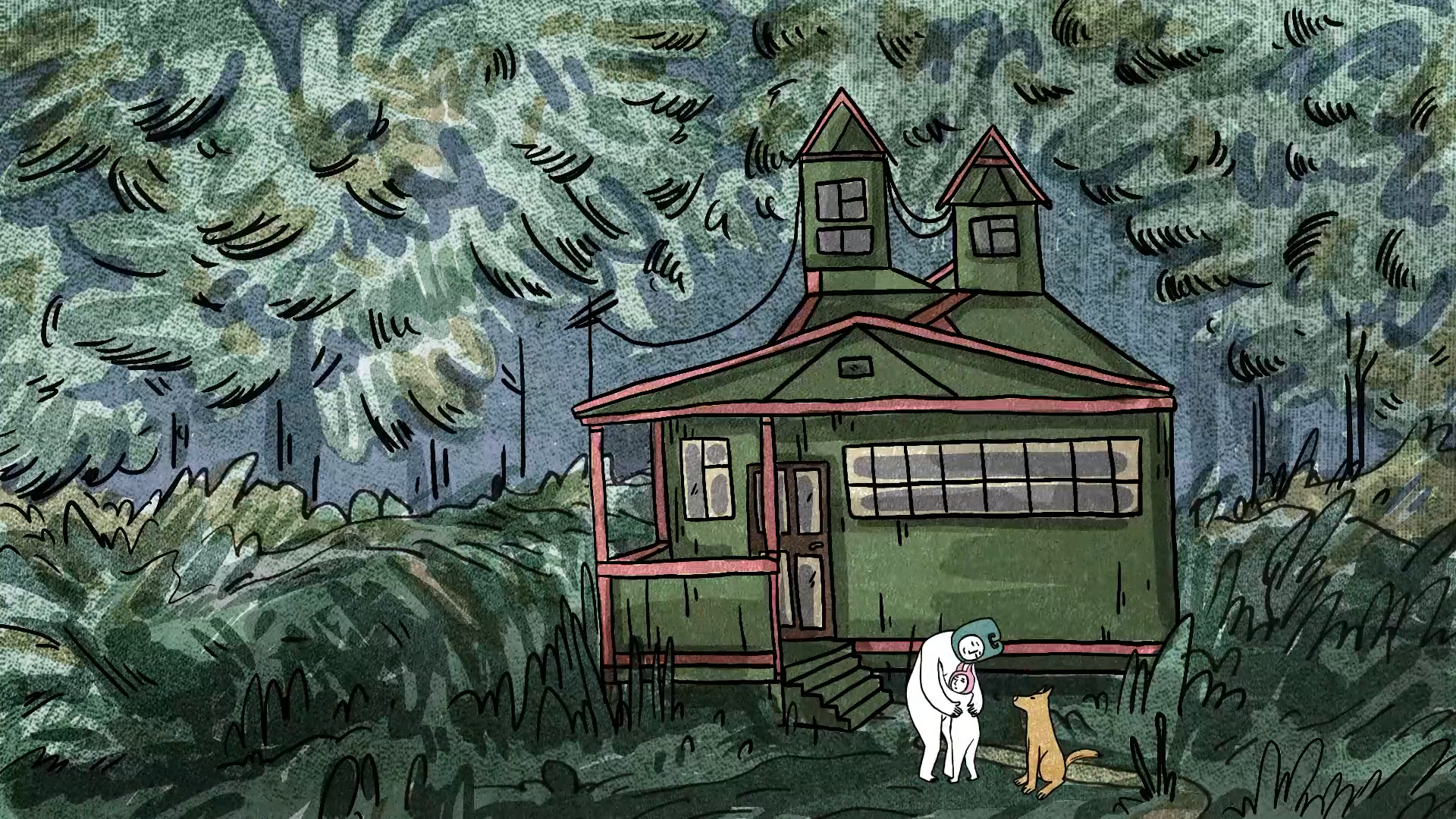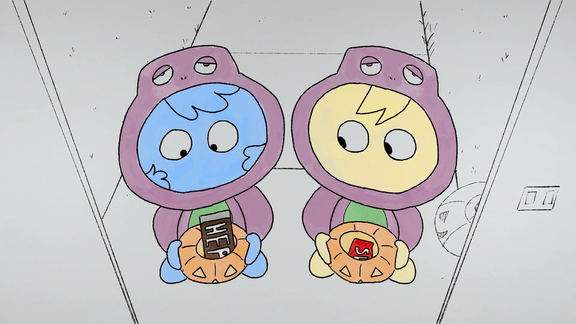Chado
Directed by DOMINICA HARRISON
United Kingdom, 2020
Drama, Experimental
Child grapples with intrusive thoughts after the death of her dog and sudden arrival of her Mother's new lover.
Read our interview with Dominica below to learn more about the film.
DOMINICA HARRISON
Est. Reading Time: 7 Minutes
MARK (M) Tell us a little about yourself - when did you become interested in film and filmmaking?
DOMINICA (D) I first tried animation during my foundation year at Camberwell College of Art. I remember I animated a monk transforming into a swan based upon an ancient buddhist belief. I drew the frames by hand on transparent acetate (at that point I didn't know about the existence of lighboxes) so when I finally saw the frames move after compositing them together, I just fell in love with hand-drawn motion. I initially wanted to be an illustrator but I quickly realized that making things move is generally more fun than making things that are static!
On 2D Animation
M I was struck by the visual aesthetic and design of your film - it's really beautiful! I loved the way you incorporated and blended different animation and print techniques to create an eloquent and vivid world. Please tell us a little about your preference for 2D animation and how it allows you to express the breadth and depth of characters and landscapes within your films.
D My practice originates from drawing so 2D animation is the most natural technique to express my ideas. I begin working in sketchbooks where I develop the way the characters will look, move and act. I do the same with environments and landscapes.
For me, 2D is the most boundless animation route as you can take shortcuts easily, and be as rough or precise as you want with the way things move. I have tried working in stop motion and cut outs and I have a lot of respect for those techniques, however I personally find that 2D has the most fluid approach. I also like how the drawn image looks aesthetically - transferred from paper, the characters and/or environments possess a certain ‘aliveness’ and playfulness that I think is quite hard to achieve in 3D animation.
On Risographs
M And similarly, please share your ideas and thoughts behind using risographs to portray the main character's dreams and visions.
D I had the idea to use risograph printing from the beginning as it was a natural progression from my last major short film Illusions, which was entirely screen-printed. This influenced the original design of the film like the limited colour scheme. The risograph dream sequences were the first images that were animated in the film - this was purely by chance as I had been invited as a resident artist at NEO: Studios and University of the Arts in Bolton just at the beginning of film production. I had unlimited access to their risograph machine so I was able to print most of the risograph sequences within my time there. The final colour scheme within the rest of the movie developed from those sequences.
The beauty of using traditional techniques like printmaking is their unpredictability. In many cases, it’s a surprise as you don't quite know what kind of image you will end up creating. In Chado, imperfections like misalignments and overlays in prints actually helped me solve some storytelling problems in a more effective and visually engaging way. It’s good to be able to trust the process and let the element of chance enter your workflow.
Some of the prints that were made during the production of Chado were exhibited in solo shows ‘Chado: Dreaming In Texture’ in Leicester Print Workshop and Bath Artists Studios in 2021.
On Themes
M I like coming-of-age stories that tackle important aspects of life so it was interesting to see the way death is explored within your film. Why were you interested in showing the journey of a young girl experiencing and grappling with the fear and reality of death?
D When the Dog dies in the film, Child is confused. She draws a connection between the insect bite and the Dog’s disappearance without fully understanding the cause and nature of the Dog’s death. When she rebels against the Stranger’s sudden presence in her life, she thinks about an obvious plan that would make her go away, which is replicating the bite that causes the Dog’s disappearance.
Coming to terms with death is a key theme. Children sometimes feel responsible for death because they believe that negative thoughts and feelings they had about the deceased caused their demise. This 'magical thinking' stems from the belief that everything in their environment revolves around them and that they control what happens around them.
‘I like how the drawn image looks aesthetically - transferred from paper, the characters and/or environments possess a certain ‘aliveness’ and playfulness that I think is quite hard to achieve in 3D animation’
— Dominica Harrison
On Inspiration
M What are some of the films and who are some of the filmmakers that inspire you, and why?
D I try to draw inspiration from many different sources but for this project I was particularly interested in looking at my early childhood inspiration. I also looked at a variety of fairy tales, especially the northern ones like books illustrated by Theodor Kittelsen. And I was very inspired by the feel and style of Maurice Sendak and Ivan Bilibin.
In terms of pacing and magic realism, I was inspired by legends like Tarkovsky and Norstein as well as Russian director Vassily Sigarev whose film Wolfy (2009) was thematically close to Chado. Stylistically, I was inspired by the new wave of risograph comics and zines that are becoming increasingly popular in Europe and United States, with independent publishing houses like Risotto, Sputnikat, Club Del Prado, Out of The Blue and Hato Press that produce beautiful work focused on design and colour.
M When you mention early childhood inspiration, the first images that come to mind are Mother greeting Child through the small window and Child playing with leeches while sitting on the porch. In addition to the general design of the home, these particular images and moments feel really personal and specific, so can you please discuss your childhood memories that inspired certain landscapes and scenes within the film?
D Yes you are very right! The house design was actually taken from my grandfather's country house (called ‘dacha’ in Russian, see picture below) where I used to spend my summers as a kid. Some of the scenes within the film came from my memories of site-specific activities like reading on the porch or passing objects through the kitchen window. We also used to collect leeches with my mum and keep them in jars to predict weather - we thought if the leeches laid low, it would be sunny but if they come up to the surface, it would rain. As a kid, I thought my mum made up this theory however when conducting research for the film, I found out that an entire barometer machine was built in the 19th century called ‘Tempest Prognosticator’ and actually used twelves leeches in individual jars filled with rainwater as a weather prediction mechanism!
On The Future
M What are you planning to make next?
D I have been working as an art lead on a longer-form animated documentary My Brother Heinz for the past year. It is directed by Meghan Horvath and portrays the holocaust stories of two siblings Eva and Heinz. The documentary is narrated by one of the siblings, Eva Scholts (who is the step-sister of renowned Anne Frank) and features oil-painted sequences based upon paintings by Heinz.
We have just begun the production stage for this project and will start posting visuals on our social media platforms soon! It is an exciting and challenging project to work on so I am really happy to be a part of it.
Aside from this, I am working on a few smaller book-related projects and developing a script for a new short film.
Mark’s Final Thoughts
Great to learn more about risographs - their grainy and rich visual texture make the dream sequences really stark which nicely contrast the elegant designs of the home and forest.
Loved getting more insight into Dominica’s childhood inspiration - you get a real sense that several images and moments are very intimate and specific, as indicated by the above-mentioned examples of Child leaning out the small window and sitting on the porch.
Furthermore, I think the strong level of detail and intimacy throughout the film reflects her wonderful instincts as a screenwriter - youth, ‘magical thinking’, drawing and nature (flora and fauna) are fantastic thematic choices because of their intrinsic connection with one another.
Didn’t get a chance to mention it in our interview but I really love the main character’s physicality - Child frequently hunching over and curling up says so much about her personality. I think it also demonstrates Dominica’s view that 2D animation creates a unique ‘aliveness’ and playfulness within characters.
Lastly, My Brother Heinz sounds like a really interesting documentary so I look forward to following its production and release.
Tags Animation Colour Death Drama Experimental Family Landscape Mental Health
Want to Learn More? Click here for Dominica’s insights into designing the film’s colour palette as well as overcoming the challenge of writing her first screenplay.
The founder of Hommage, Mark Shaba published this interview on 23.12.2021. Mark is a filmmaker from Victoria, Australia. He respectfully acknowledges the past and present traditional owners of the land on which he creates, promotes and screens art, the Wurundjeri people of the Kulin nation who are the custodians.




























